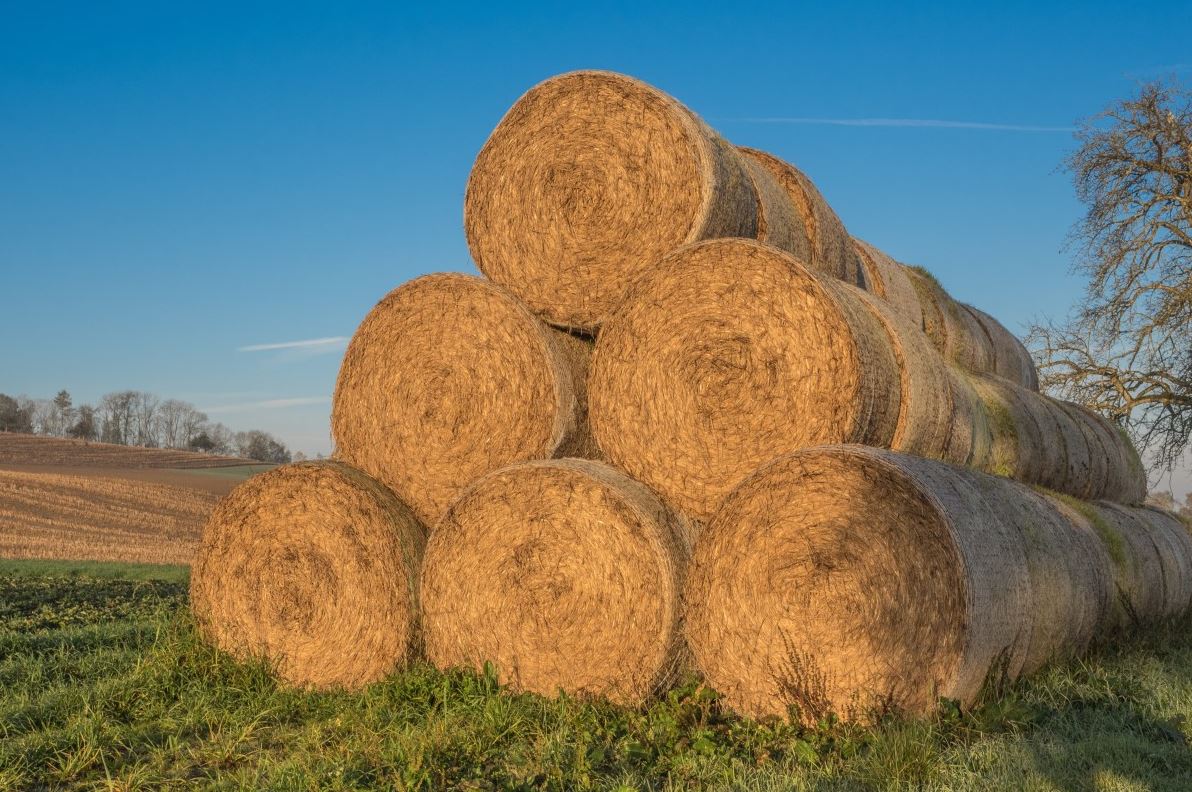How hay quality is impacted by storage conditions?
In a previous article about lab testing the quality of your hay, we briefly mentioned that the storage conditions are essential to preserving its quality. In fact, the way you store hay after baling could have a bigger impact than you may think on hay quantity and quality losses.

Why does hay lose quality?
Before detailing the difference between various storage conditions, it is important to understand why and how hay loses quality. The lost of quality once the hay is cut and harvested is mosty due to three factors: temperature, moisture and time.
Every farmer or rancher know that drying hay generates heat. The heat generated by the hay while drying is due to a very natural process. Microorganisms (bacteria) develop in the hay and start to consume the hay’s nutrients, which causes chemical reactions (causing the heat). In a warm and moist environment, the microorganisms proliferate more rapidly. And of course, the more they have time to “eat” and reproduce, the more damage they do.
According to research by Oklahoma State University, losses after 12 to 18 months of storage are twice as great as losses after nine months of storage.
What are the different types of storage?
Buildings (barns, sheds…)
This option covers all types of permanent hay storage structures including sheds with an roof and exposed sides, or roof with three enclosed sides. End bales stored in open-ended buildings can be covered with tarps or cloth, or doors installed to prevent bleaching.
Semi-permanent covers (tarps, plastic panels…)
These include plastic panels or reusable heavy-duty tarpaulins that cover the top bales in the stack, or tarpaulins that are stretched over a steel frame. These covers should be treated to avoid photo-degradation by UV light and should have some means of distributing the strain of tie-downs across the length of the stack. The tarpaulins are usually made from polyethylene or polypropylene and should last five to seven years.
Uncovered pads
Bales stacked on the ground with no cover are, of course, the cheapest method of hay storage, but have the highest potential of weathering loss. Much of this loss occurs on the bottom of the bale where moisture levels remain highest and air movement is lowest. Outside storage losses can be reduced by installing a drained site and placing coarse gravel or materials such as timber to break the contact with the damp soil and provide air space between the bottom of the bale and the soil surface.
| Buildings | Semi-permanent covers | Uncovered | |
| Advantages | Lowest dry matter losses (5–10%), higher nutritional value, digestibility and palatability. Shed has other potential uses (other than hay storage). |
Lower dry matter losses than uncovered stacks. Tarpaulins are relocatable, quick to install, multipurpose cover or liner. |
Simple, low capital cost |
| Disadvantages | Fixed, hay has to be transported to and from the shed. High capital cost. |
Wind can affect security of the cover. Rainfall can collect on the cover UV exposure and birds can decrease life span. |
Highest dry matter losses (30–60%). Greater losses from round bales (loss increases with smaller bale diameter) Regions with higher rainfall and humidity have higher rates of hay spoilage and/or dry matter losses |
| Life span | 20+ years | 2–10 years (depending on the use of UV stabilisers | Highly variable depending on the climate and site preparation/maintenance |
Tips, facts & figures
- Storing hay under cover preserves dry matter, nutrients and quality and may reduce shrinkage by 30%.
- Storing hay under cover reduces spoilage and contamination.
- By volume and mass, rectangular bales are more cost-effective to transport and stack in a covered storage system.
- Exposed hay or shed openings should face away from the prevailing wind to minimise rain damage.
- Uncovered storage areas should be graveled to accommodate vehicle loadings and all-weather access.
- Uncovered or temporary storage areas should have a corrugated cross-section to help drainage.
- Orientate uncovered hay in rows running north-south to increase the bale exposure to the sun.
- Stacks of hay should be separated to increase airflow between bales, provide good ventilation and allow access for tying down tarpaulins.
What to conclude?
Hay quality deteriorates over time, no matter the way you decide to store it. However, storage conditions have an impact on the overall quality of the hay.
Besides losing dry matter, uncovered hay also loses quality, as determined by nutritional analysis and appearance. The loss in dry matter reduces weight available for sale and the loss in quality can have a large impact on animal performance and hay value.
The University of Minnesota West Central Research and Outreach Center in Morris studied different hay storage methods in Minnesota conditions. For example, the internal parts of bales stored in the shed had a relative feed value (RFV) of 133, while the bottom six inches of the bales at the bottom of the pile had an RFV of 106. The internal parts of bales stored uncovered, outside on sod had an RFV of 114, while the bales’ external parts had RFVs ranging from 55 to 107.
In just eight months, the differences in hay weight, quality and price resulted in hay stored in the shed being worth about US $3,350 more per 100 tons harvested than hay stored outside on sod. These numbers show it’s worth considering an investment in tarps and gravel, or even hay storage sheds – depending on the size of your operation and your investment capacity.


























